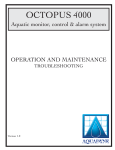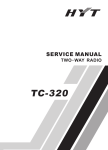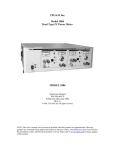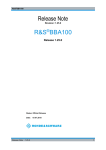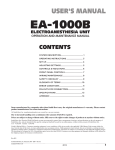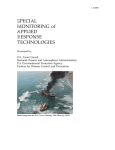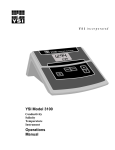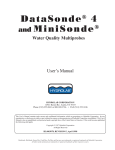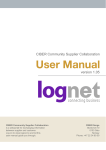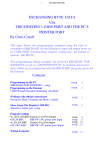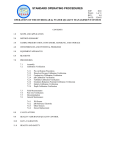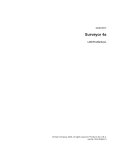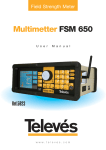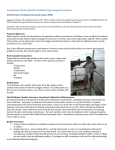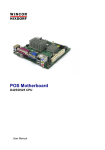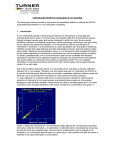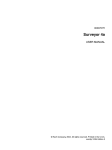Download Manta 2 - Hydroterra
Transcript
Multiprobe User Manual Manta 2, Sub 2 and Sub 3 Water-Quality Multiprobe Manual Manta 2, Sub2, and Sub3 Water-Quality Multiprobe Manual Measurement Specialties, Inc. 2113 Wells Branch Pkwy. Suite 4400, Austin, TX 78728 www.meas-spec.com 1-512-302-4333 [email protected] 1-800-745-8008 Multiprobe User Manual Manta 2, Sub 2 and Sub 3 Water-Quality Multiprobe Manual Note: Unless otherwise mentioned, “Manta 2” means Manta 2, Sub2, and Sub3. Eureka, Manta 2, Sub2, and Sub3 are trademarks belonging to Measurement Specialties, Inc. Q: Why do Mantas have transparent housings? A: Three reasons: 1) 1) We’re proud of the workmanship that goes into building Mantas, so we want everyone to see inside, too. 2) 2) A clear housing lets you monitor your o-ring seals and lets you remedy a leak before it destroys circuit boards, should you be so unfortunate as to have a leak. 3) Three LED’s inside the Manta 2 that tell you such things as whether or not the Manta is receiving adequate voltage to operate. Q: Do you have telemetered buoys in the field? A: Yes. We can provide all the instrumentation and hardware, but often our customers prefer to provide their own buoys. Measurement Specialties, Inc. 2113 Wells Branch Pkwy. Suite 4400, Austin, TX 78728 www.meas-spec.com 1-512-302-4333 [email protected] 1-800-745-8008 Multiprobe User Manual Manta 2, Sub 2 and Sub 3 Water-Quality Multiprobe Manual Contents QS Quick Start - Learning the Manta 2 in 30 Minutes QS1 QS2 QS3 Talk to Your Manta 2: Loading the Manta 2 Software on Your PC Exploring the Manta 2 User-Interface Software Manta 2 Instructional Videos A The Manta 2 A1 A2 A3 A4 A5 A6 A7 A8 A9 Example Systems and Applications Manta 2 System Components Applications: Profiling (Spot-Checking), Logging, and Telemetry Cables What do the LED lights mean? Operating the Manta 2 with Eureka’s Amphibian 2 (Archer) Flow Cell Routine Maintenance Technical Sheets B The Manta 2 Control Software B1 B2 B3 B3a B3b B3c B3d B3e B3f B4 B4a B4b B4c B4d B4e B4f B4g B4h Main Screen Hot Buttons “PC” Pull-Down Menu Set Scroll Interval Set Snapshot Location Automatic Snapshot Graphing COM Ports Control Software Version Manta 2 Pull-Down Menu Manage Manta 2 Files Logging Set-Up Calibration Record Sensors and Parameters List Calibrate Manta 2 Version Create a Custom Parameter Delete a Custom Parameter Measurement Specialties, Inc. 2113 Wells Branch Pkwy. Suite 4400, Austin, TX 78728 www.meas-spec.com 1-512-302-4333 [email protected] 1-800-745-8008 Multiprobe User Manual Manta 2, Sub 2 and Sub 3 Water-Quality Multiprobe Manual C Sensors and Calibrations C1 C2 C3 C4 C5 C6 C7 C8 C9 C10 C11 C12 C13 C14 C15 C16 C17 The Difference between Sensors and Parameters Basics of Parameter Calibrations Calibration Record (“Cal Log”) Sensor Response Factor (SRF) Temperature Dissolved Oxygen, Optical Sensor Conductivity pH Reference Electrode Oxidation-Reduction Potential (ORP) Depth and Vented Depth (Stage) Turbidity Fluorometers Ion-Selective Electrodes Total Dissolved Gas (TDG) PAR Set Barometric Pressure and Set Time and Date D Logging D1 D2 D3 D4 D5 D6 D7 D8 D9 D10 D11 D12 D13 D14 What’s the difference between “Logging” and “Snapshot”? Why We Do Logging the Way We Do Logging Files Activating Manta 2 Logging Logging Interval Sensor Warm-Up Internal Battery Packs External Battery Packs Hybrid Battery Packs Am I using Battery Pack power or Cable power? Logging Redundantly with Telemetry Dumping Data from the Manta 2 Controlling Sensor Fouling Pipe Kit Measurement Specialties, Inc. 2113 Wells Branch Pkwy. Suite 4400, Austin, TX 78728 www.meas-spec.com 1-512-302-4333 [email protected] 1-800-745-8008 Multiprobe User Manual Manta 2, Sub 2 and Sub 3 Water-Quality Multiprobe Manual E Troubleshooting and Warranty Information E1 E2 E3 E4 Troubleshooting Opening the Manta 2 Performance Specifications and Dimensions Warranty Measurement Specialties, Inc. 2113 Wells Branch Pkwy. Suite 4400, Austin, TX 78728 www.meas-spec.com 1-512-302-4333 [email protected] 1-800-745-8008 Multiprobe User Manual Manta 2, Sub 2 and Sub 3 Water-Quality Multiprobe Manual Quick-Start Guide: Learning the Manta 2 in 30 Minutes If you have experience with multiprobes – you know what a cable looks like and you know what a pH buffer is – you can get by just fine reading the Quick Start Guide and Section B. Others should at least skim the sections on software and sensors. QS1 Talk to Your Manta 2: Loading Manta 2 Software onto Your PC To communicate with your Manta 2, your PC needs the Manta 2 Control Software and the USB-Serial converter. Here’s how to install those programs onto your PC: 1) Find the Eureka Environmental Install disc that was shipped with your Manta 2. 2) Place the disc into your PC’s CD-ROM drive tray, label side up, and close the tray. 3) Soon you will see the start-up screen; click the button called “Install Manta 2 Software” and follow the instructions on the screen. 4) The Manta 2 Control Software’s main screen will automatically appear, displaying real-time data from your Manta 2: Measurement Specialties, Inc. 2113 Wells Branch Pkwy. Suite 4400, Austin, TX 78728 www.meas-spec.com 1-512-302-4333 [email protected] 1-800-745-8008 Multiprobe User Manual Manta 2, Sub 2 and Sub 3 Water-Quality Multiprobe Manual Manta 2 Control Software 5) Now that you know that the Manta 2 Control Software is successfully installed, close the program by clicking the X in the upper righthand corner. 6) Finally, click on the Start button in the lower left of your PC screen, and click on All Programs. Then click on the Eureka Environmental folder and left-click on the name Manta 2 Control Software and drag it to your Desktop. You now have a Manta 2 Control Software “fish” shortcut icon on your Desktop (as shown to the left); click the fish to open the Manta 2 Control Software. This software installation process should take only a few minutes. Please call us (512-302-4333) if you have any problems. Measurement Specialties, Inc. 2113 Wells Branch Pkwy. Suite 4400, Austin, TX 78728 www.meas-spec.com 1-512-302-4333 [email protected] 1-800-745-8008 Multiprobe User Manual Manta 2, Sub 2 and Sub 3 Water-Quality Multiprobe Manual QS2 Exploring the Manta 2 User-Interface Software On the following page is the Manta 2 Control Software flow chart. You can experiment with the software until you see how to calibrate sensors, activate logging, etc. You can’t break anything because every option has a “Cancel” button, which takes you back to the Main Screen without altering anything. Note that the Manta 2 control software used by the Amphibian 1 and Amphibian 2 (Archer) is almost identical to that for the PC, and should be equally self-explanatory. Section E5 shows many of the Amphibian screens so that you’ll know what you’re seeing. QS3 Manta 2 Instructional Videos There are two Manta 2 instructional videos available on YouTube: Multiprobe set-up instructions http://www.youtube.com/watch?v=kWeNohMKMRo Manta 2 Calibration http://www.youtube.com/watch?v=eh4IYT36sFQ Measurement Specialties, Inc. 2113 Wells Branch Pkwy. Suite 4400, Austin, TX 78728 www.meas-spec.com 1-512-302-4333 [email protected] 1-800-745-8008 Multiprobe User Manual Manta 2, Sub 2 and Sub 3 Water-Quality Multiprobe Manual Manta 2 Control Software Flowchart PC or Amphibian select your choice of scrolling intervals from the chart Set PC or Amphibian Scroll Interval MS Windows standard "Save As" function Set Snapshot Location automatically log data to your PC at an interval of your choosing Automatic Snapshot view real-time data in graphical form Graphing select your choice of USB ports from the chart COM Ports Manta 2 Manage Manta 2 Files Logging Set-Up Calibration Record Sensors and Parameters List 2113 Wells Branch Pkwy. Suite 4400, Austin, TX 78728 select your choice of logging interval, turbidity wipes, and Manta 2 file names view details of all calibrations made to your Manta 2 select your choice of parameters, and their order of appearance, from the chart Calibrate Manta Version Measurement Specialties, Inc. view or delete Manta 2 files, or export Manta 2 files to your PC Barometric Pressure select any of three methods for telling your Manta 2 the local BP Time & Date type in the correct time and date, or synchronize with your PC SC in uS/cm, pH (2-point), Depth, Level, … follow the parameterspecific instructions for calibrations www.meas-spec.com 1-512-302-4333 [email protected] 1-800-745-8008 Multiprobe User Manual Manta 2, Sub 2 and Sub 3 Water-Quality Multiprobe Manual Q: How did you design such a reliable instrument? A: First, we had about two man-centuries of experience in building multiprobes. And then it was test, test, test, and more tests. We tested our instruments against their specifications and against other multiprobes on the market. Q: Can I save money if I buy a complete package? A: Yes. Ask for the Sub2 or the Sub3 Manta 2 packages. Measurement Specialties, Inc. 2113 Wells Branch Pkwy. Suite 4400, Austin, TX 78728 www.meas-spec.com 1-512-302-4333 [email protected] 1-800-745-8008 Multiprobe User Manual Manta 2, Sub 2 and Sub 3 Water-Quality Multiprobe Manual A The Manta 2 A1 Manta 2 System Components Clockwise from the top: Manta 2 and its underwater cable, storage/calibration cup, maintenance kit, software disc and data cable, USB adapter, weighted sensor guard. The Manta 2 system comprises these components: Manta 2 Multiprobe – Each unit is custom configured with your choice of sensors, and comes with or without a battery pack. Underwater Cable – The underwater cable connects the Manta 2 to a PC, Amphibian Data Display, or telemetry device. Storage/Calibration Cup – With the lid screwed on, the storage/calibration cup should contain a few ounces of tap water to keep the sensors moist. Do not overfill, and do not allow the Measurement Specialties, Inc. 2113 Wells Branch Pkwy. Suite 4400, Austin, TX 78728 www.meas-spec.com 1-512-302-4333 [email protected] 1-800-745-8008 Multiprobe User Manual Manta 2, Sub 2 and Sub 3 Water-Quality Multiprobe Manual water to freeze. Do no store in anything other than tap water. With the lid removed, the storage/calibration cup is used to hold calibration standards when calibrating the sensors. Maintenance Kit – This kit contains spare DO membranes and DO electrolyte (if you ordered a Clark dissolved oxygen sensor), reference electrode filling solution (if you ordered pH), o-ring grease (please use this liberally, especially on the o-rings of the underwater cable connector). Manta Control Software – This software allows you to connect the Manta directly to your PC through a USB port. You can view data, set up logging files, and calibrate your instrument. USB Adapter – Use this cable to connect the Manta to your computer via a USB port. Do not use the USB adapter cable with anything but your PC and a Manta 2. Weighted Sensor Guard – Replace the storage/calibration cup with the weighted sensor guard just before using your Manta 2 in the field. Unlike the products of lesser manufacturers, the Manta 2 uses the same basic components regardless of how many sensors you order. Most importantly, we have a No-Cramming Rule that prevents our stuffing too many sensors into an artificially small instrument diameter. Yes, we know that you like small instruments, but cramming sensors together usually results in sensors whose performance, reliability, and repair or maintenance ease is compromised. Measurement Specialties, Inc. 2113 Wells Branch Pkwy. Suite 4400, Austin, TX 78728 www.meas-spec.com 1-512-302-4333 [email protected] 1-800-745-8008 Multiprobe User Manual Manta 2, Sub 2 and Sub 3 Water-Quality Multiprobe Manual So, when you ordered your Manta 2, one of the product specialists determined the optimum housing diameter for the sensors you selected. The Manta 2 sizes (outside diameters) are 2 inches (actually 1.95), 2.5 inches (2.45), 3 inches (2.95), 3.5 inches (3.50), 4 inches (4.00), and occasionally even 4.5 inches (4.50). Anytime you wish to add or subtract sensors, we can use all of your Manta 2’s circuit boards and sensors in a larger or smaller housing. You don’t have to change from one model instrument to another. All Manta 2’s are approximately 16 inches tall, including the weighted sensor guard and cable locking sleeve. A2 Connecting the Manta 2 to a PC First, go back to the Quick Start Guide to see how to load your software if you have not already done so. Next, connect your Manta 2 to your PC with the USB adapter and either a calibration cable or underwater cable (see picture in Quick-Start Guide). Then click on the Manta 2 Control Software program shortcut icon on your PC desktop. The first screen you see - the one with the rolling, real-time data - is called the Main Screen, which you can read more about in Section B. A3 Applications: Telemetry Profiling (Spot-Checking), Logging, and The Manta 2, which can be used in any natural water up to 50 degrees C and 200 meters depth, has three basic applications. First, it can be used manually to gather data in the field if you have a cable and an Amphibian or notebook PC. You might take a series of measurements in one or more lakes or streams during the day, and then download any saved data to your desktop PC that evening. Second, it can run unattended for weeks at a time with a battery pack. You can, for instance, set the instrument to take a set of readings every Measurement Specialties, Inc. 2113 Wells Branch Pkwy. Suite 4400, Austin, TX 78728 www.meas-spec.com 1-512-302-4333 [email protected] 1-800-745-8008 Multiprobe User Manual Manta 2, Sub 2 and Sub 3 Water-Quality Multiprobe Manual half-hour, anchor it in an estuary, and return after two weeks to retrieve the instrument and download the data. Third, the Manta 2 can connect to a data telemetry system. A data logger, battery with solar panel, and modem takes data from the multiprobe and transmits them to a Website of your choosing. The Manta 2’s internal logger can be used as a data back-up, and a Manta 2 battery pack can be used as a power back-up. This method has the advantage of maximizing deployment times (i.e. minimizing labor costs) because the user can watch his data over the Internet to determine when maintenance is required. Telemetry is also ideal in locations for which access is dangerous or expensive. Any Manta 2 can operate with the EagleEye™ data telemetry system. It’s inexpensive, very easy to use, and uses a solar-charged battery to support cell phone and satellite communications. We provide a website to collect, arrange and archive the data. A4 Cables Our cables have a special lower termination in which the cable wires can move around when it is stressed one way or another – such as when the Manta 2 is suspended from a bridge. Measurement Specialties, Inc. 2113 Wells Branch Pkwy. Suite 4400, Austin, TX 78728 www.meas-spec.com 1-512-302-4333 [email protected] 1-800-745-8008 Multiprobe User Manual Manta 2, Sub 2 and Sub 3 Water-Quality Multiprobe Manual This means that the chance of breaking a cable through normal use is very small. Generally, just make sure the cable is kept clean and that you don’t run it over the side of the boat without a gentle radius for the cable. And make sure to use the cable’s locking sleeve (or locking plate for the internal-battery-pack-equipped models). The cables used with the optional vented level sensor contain a small tube that connects the level-measuring transducer to the surface of the water so that changes in barometric pressure do not affect level readings. The small tube is connected to a desiccant pack to prevent water from condensing tin the vent tube. A5 Operating the Manta 2 with the Amphibian 2 (Archer) First, read the Amphibian 2 manual. Second, connect the Amphibian 2 to your Manta 2 cable’s 9-pin connector. Three, you’re done, as the Amphibian 2 uses the same type of program as is used on the PC. A6 What do the LED lights mean? The Manta 2 has three light-emitting diodes (LED’s) mounted on the circuit board visible through the instrument housing to help you understand what’s happening, and to provide information when troubleshooting a failure: Green – blinks every second when receiving adequate operating voltage via the cable; it does not blink when the Manta 2 operates under its own battery power Red – blinks 5 times upon power-up when logging is enabled Amber - blinks when receiving RS-232 communications Measurement Specialties, Inc. 2113 Wells Branch Pkwy. Suite 4400, Austin, TX 78728 www.meas-spec.com 1-512-302-4333 [email protected] 1-800-745-8008 Multiprobe User Manual Manta 2, Sub 2 and Sub 3 Water-Quality Multiprobe Manual A7 Flow Cell If you wish to pump sample water to your Manta 2, for instance from a ground-water well, you can simply screw a flow cell onto the Manta 2 as you would normally screw on a sensor guard. Be sure to limit the pressure in your sample lines to 15 psi so that you don’t blow the flow cell off the multiprobe. A8 Routine Maintenance Clean your instrument periodically with warm soapy water. Liquid dishwashing soap is fine. Do not use abrasives. Do not use acetone. Do not clean with gasoline, kerosene, or industrial cleaners. Mild household cleaners work well. Clean sensor stems with a soft brush. Rinse well with tap water, and store sensors with tap water in the storage cup. A9 Technical Sheets The Technical Sheets available for the Manta 2 are listed below. They are not printed in all manuals because we don’t want our manual to weigh as much as do the competitions’ manuals. Please call or e-mail for copies, or check our web site for downloads. F1 - Manta 2 SDI-12 Adapter 113 F2 - Manta 2 Communications Protocol 113 F3 - Manta 2 Power Options 113 F4 - Manta 2 Bluetooth Operation 113 Measurement Specialties, Inc. 2113 Wells Branch Pkwy. Suite 4400, Austin, TX 78728 www.meas-spec.com 1-512-302-4333 [email protected] 1-800-745-8008 Multiprobe User Manual Manta 2, Sub 2 and Sub 3 Water-Quality Multiprobe Manual F5 - The Nature of Ion-Selective Electrodes and the Difference between Concentration and Activity 113 F6 - Calibrating Eureka’s Turner Fluorometers (Chlorophyll, B/G Algae, etc.) F7 - Manta 2 Logging with an Uninterrupted External Power Supply 113 F8 - Luminescent and Fluorescent DO Sensors 113 Q: Do you have anti-fouling methods? A: Yes, including various wipers, copper parts, and a unique method for slowly dissolving copper gauze in the water near the sensors. Measurement Specialties, Inc. 2113 Wells Branch Pkwy. Suite 4400, Austin, TX 78728 www.meas-spec.com 1-512-302-4333 [email protected] 1-800-745-8008 Multiprobe User Manual Manta 2, Sub 2 and Sub 3 Water-Quality Multiprobe Manual B The Manta 2 Control Software B1 Main Screen We call the Manta 2 Control Software’s main screen the “Main Screen” because it’s the screen that first appears when you click on the Manta 2 Control Software icon, and because you can access all the Manta 2 functions from this screen. The Main Screen functions are: These two buttons are pull-down menus. This area is continuously updating, realtime data from your Manta 2. Measurement Specialties, Inc. 2113 Wells Branch Pkwy. Suite 4400, Austin, TX 78728 These six buttons are “hot buttons” – short-cuts to important and often-used functions. The bottom line of the screen tabulates some information you might find handy. The line of data highlighted in yellow is the most recent line of data sent from the Manta 2. www.meas-spec.com 1-512-302-4333 [email protected] 1-800-745-8008 Multiprobe User Manual Manta 2, Sub 2 and Sub 3 Water-Quality Multiprobe Manual B2 Hot Buttons “Hot Buttons” are the little squares you can click on to do something important without leaving the Main Screen. If this button says “ON”, click on it to turn Manta 2 logging off. If this button says “OFF”, click on it to turn Manta 2 logging on. Click this button to toggle your circulator, if any, on and off. When you click on this button, a comment screen appears (see below), and then one frame of data is sent to your PC Snapshot file (along with the comment you typed in the box). The comment is called an annotation. Measurement Specialties, Inc. 2113 Wells Branch Pkwy. Suite 4400, Austin, TX 78728 Click this button to start one wipe cycle for your turbidity sensor, if any. Click on this button to send one frame of data to your PC Snapshot file without an annotation. Click on this button to clear the data area. www.meas-spec.com 1-512-302-4333 [email protected] 1-800-745-8008 Multiprobe User Manual Manta 2, Sub 2 and Sub 3 Water-Quality Multiprobe Manual Click the “Manta 2 logging is OFF” (or, “Manta 2 logging is ON”) hot button to enable or disable the Manta 2’s logging function. This button doesn’t actually turn logging on or off – you do that in the field as explained in Section D3. It lets you tell the Manta 2 that you might be deploying the Manta 2 in the field for unattended logging. Clicking the hot button toggles the logging on and off. Generally, logging should be off – turn logging to ON only when you’re preparing for unattended deployment. Click the “Circulator is OFF” (or “Circulator is ON”) hot button to turn the circulator ON and OFF. Most of you will not have circulators, as they are seldom used except when you have a Clark-type dissolved-oxygen sensor. Click the “Wipe one cycle now” hot button to activate one cycle of the turbidity sensor’s wiper. If your Manta 2 doesn’t have turbidity, you can still click this button, but nothing will happen. Click the “Capture One Line of Data to PC without Annotation” hot button to save the most recent line of data (as shown in the yellow band on the Main Screen) to your Snapshot file (see Section B3b). Click the "Capture One Line of Data to PC with Annotation" hot button to save the most recent line of data (as shown in the yellow band on the Main Screen) to your Snapshot file, along with a brief note that you might wish to append to the data. Type that note in the annotation box (see below); the note will be saved, along with the data, in your Snapshot file (see Section B3b). Click the “Clear Data from PC Screen” hot button to remove the data you see on the screen, and start over with only the most recent data. Clicking this button does not close the program. Measurement Specialties, Inc. 2113 Wells Branch Pkwy. Suite 4400, Austin, TX 78728 www.meas-spec.com 1-512-302-4333 [email protected] 1-800-745-8008 Multiprobe User Manual Manta 2, Sub 2 and Sub 3 Water-Quality Multiprobe Manual B3 “PC” Pull-Down Menu The Manta 2 has two pull-down menus, called PC and Manta 2. They’re called pull-downs because when you click on them, a bunch of hidden buttons appear. When you click on the “PC” pulldown menu, you get six buttons to choose from: B3a Set Scroll Interval Click on “Set Scroll Interval” if you wish to change the time for which lines of data on your PC or Amphibian screen are updated. You can click on a specific scroll interval, or type in your own. Measurement Specialties, Inc. 2113 Wells Branch Pkwy. Suite 4400, Austin, TX 78728 www.meas-spec.com 1-512-302-4333 [email protected] 1-800-745-8008 Multiprobe User Manual Manta 2, Sub 2 and Sub 3 Water-Quality Multiprobe Manual B3b Set Snapshot Location A “snapshot” is what happens when you choose to log, or store, one line of data. That line can be representative of, say, stabilized readings at 10 meters in a particular lake, or any other line of data you find interesting. If you want to find those interesting lines of data later, it’s a good idea to put them in a file whose location you can remember. Click on “Set Snapshot Location” if you wish to specify the file in which your snapshots are to be filed. This calls up the standard “Save As” function of your PC’s Windows operating system. Follow the instructions just as if you were saving a new Word document. Notice that the Snapshot File location is listed on the bottom line of the Main Screen, for your convenience. B3c Automatic Snapshot Automatic Snapshot lets you log data automatically and quickly, i.e., if you wish to catch a transient situation or if you are rapidly profiling a column of water. The data are stored in the Snapshot file as determined by “Set Snapshot Location” (see Section B3b). In Automatic Snapshot, data are logged at the same interval as they are displayed on your PC or Amphibian screen when you’re not in Automatic Snapshot. Example: if you have set your scroll interval to 10 seconds (see Section B3a), Automatic Snapshot will record data at 10-second intervals. Measurement Specialties, Inc. 2113 Wells Branch Pkwy. Suite 4400, Austin, TX 78728 www.meas-spec.com 1-512-302-4333 [email protected] 1-800-745-8008 Multiprobe User Manual Manta 2, Sub 2 and Sub 3 Water-Quality Multiprobe Manual B3d Graphing Click on graphing to see your M2 data in graphical form B3e COM Ports When you click on its icon on your Desktop, the Manta 2 Control Software searches all active USB ports until it finds a Manta 2 to talk to, and then it stops looking. But you might have more than one Manta 2 connected to your PC at one time if you are calibrating several Manta 2’s at the same time or are using your PC to monitor several Manta 2’s at the same time (like in a fish hatchery with multiple tanks). In that case, you can click on “COM Ports” to change the USB port that your Manta 2 Control Software uses to talk to your Manta 2. Note: The Manta 2 Control Software is so smart that it determines, and then lists in the COM Ports screen, all the COM ports that your PC knows about. B3f Control Software Version Click this icon to get a screen that tells you the software version that your PC or other device is using to talk to your Manta 2. Measurement Specialties, Inc. 2113 Wells Branch Pkwy. Suite 4400, Austin, TX 78728 www.meas-spec.com 1-512-302-4333 [email protected] 1-800-745-8008 Multiprobe User Manual Manta 2, Sub 2 and Sub 3 Water-Quality Multiprobe Manual B4 “Manta 2” Pull-Down Menu When you click on the other of the menu pull-downs, “Manta 2”, you get eight buttons to choose from: B4a Manage Manta 2 Files Click on Manage Manta 2 Files to see the names of all the data files that are stored in your Manta 2. Highlight the file(s) you’re interested in by clicking on it. Then, with the other buttons on the screen, you can then view that file on your PC screen, delete that file, or export it to your PC (via the Save As function standard to Windows). Measurement Specialties, Inc. 2113 Wells Branch Pkwy. Suite 4400, Austin, TX 78728 www.meas-spec.com 1-512-302-4333 [email protected] 1-800-745-8008 Multiprobe User Manual Manta 2, Sub 2 and Sub 3 Water-Quality Multiprobe Manual B4b Logging Set-Up All Manta 2’s include lots of data memory and software that automatically logs (stores) a line of data any time you want. The Logging Set-Up screen lets you change any or all of the instructions the Manta 2 will follow when logging. You can click on your preferred logging interval. You can also elect to append any new data to a file that already exists in the Manta 2 by clicking “Browse Manta” and clicking on “OK”, or you can create a new Manta 2 logging file by typing the new file name under “Log File Name”. For your convenience, the active logging file name is displayed in the bottom line of the main screen. B4c Calibration Log Click on the Cal Log button to see the calibration record. This is a lifetime, permanent record of all calibration changes for your Manta 2. Please see C3 for more information. Measurement Specialties, Inc. 2113 Wells Branch Pkwy. Suite 4400, Austin, TX 78728 www.meas-spec.com 1-512-302-4333 [email protected] 1-800-745-8008 Multiprobe User Manual Manta 2, Sub 2 and Sub 3 Water-Quality Multiprobe Manual B4d Sensors and Parameters List A sensor is a basic sensing element, for instance a thermistor senses temperature. A parameter is a type of data derived from that sensor, like, in the case of temperature, degrees Fahrenheit and degrees Centigrade. Click on Sensors and Parameters List to see all the parameters supported by the Manta 2. You enable these parameters by clicking in the box (to the left of the parameter name) to produce the check mark. Clicking on a box with a check mark removes the check mark and disables that parameter. The order of the enabled parameters in this list is the order in which the parameters will appear in your PC or Amphibian Main Screen, the order in which they will appear in logging files, and the order in which they will appear in Snapshot files. You can change the parameter order by clicking on (i.e. highlighting) the parameter name and then moving the highlighted name up or down by clicking on the up- and downarrows at the bottom of the screen. Measurement Specialties, Inc. 2113 Wells Branch Pkwy. Suite 4400, Austin, TX 78728 www.meas-spec.com 1-512-302-4333 [email protected] 1-800-745-8008 Multiprobe User Manual Manta 2, Sub 2 and Sub 3 Water-Quality Multiprobe Manual B4e Calibrate Clicking on Calibrate in the Manta 2 pull-down menu gives you a screen listing all the parameters that can be calibrated in a Manta 2. Click on the parameter you wish to calibrate to see its Calibrate screen. This screen has calibration instructions for the specific parameter and shows the current reading for that parameter. If your calibration requires a calibration standard, type your calibration standard value where it says “enter calibration value:” When the parameter reading has stabilized in the calibration solution, click on the OK button. If your calibration has an acceptable SRF (Sensor Response Factor, an indication of the sensor condition; please see Section C4), the calibration will be accepted and you will be returned to the Main Screen. If the SRF is not acceptable, a box will pop up and caution you about the feasibility of your calibration. If you click on “OK”, the calibration will be accepted despite a deviant SRF, and you will be returned to the Main Screen). If you click on “Cancel”, you’ll go back to the Calibrate screen. Measurement Specialties, Inc. 2113 Wells Branch Pkwy. Suite 4400, Austin, TX 78728 www.meas-spec.com 1-512-302-4333 [email protected] 1-800-745-8008 Multiprobe User Manual Manta 2, Sub 2 and Sub 3 Water-Quality Multiprobe Manual How do I know if I need to calibrate? The simple answer is that frequent calibration will give you better data. The more meticulous you are with calibration, the better data you will gather. If you are uncertain whether you need to calibrate, check your sensors against a known sample. If the reading is within the accuracy specification and/or your accuracy expectations, there is no need to calibrate. Experience and your program’s accuracy expectations will help determine calibration frequency for the various sensors. If, for instance, your reservoir discharge is hovering near the regulatory minimum for dissolved oxygen, you should pay special attention to DO calibration frequency and technique. On the other hand, if a conductivity accuracy of +/- 10% is OK, you needn’t calibrate conductivity very often. If you replace the DO membrane (Clark cell) or pH reference solution, you should recalibrate. B4f Manta 2 Version Click this button to see the version number for the software that your Manta 2 is using. B4g Create a Custom Parameter Suppose you determined the relationship, specific to your waters, between conductivity and total dissolved solids (TDS). Or suppose you wanted to transform your turbidity readings so they would more closely match turbidity readings for a well-known MEAS competitor (for the sake of continuity in data records, not for the sake of accuracy). Or suppose you had an algorithm relating water level to flow for a certain site. With the Manta 2, you can create new parameters – call them My TDS, Site 4b Flow, etc. – that will show up on your main screen and logged data just like temperature, pH, and all the other parameters. Measurement Specialties, Inc. 2113 Wells Branch Pkwy. Suite 4400, Austin, TX 78728 www.meas-spec.com 1-512-302-4333 [email protected] 1-800-745-8008 Multiprobe User Manual Manta 2, Sub 2 and Sub 3 Water-Quality Multiprobe Manual To make this happen, click on the Manta 2 pull-down menu, and click on Create Custom Parameter. Follow the instructions to name your new parameter, specify the units that you wish the new parameter reported in (e.g. mg/l for TDS), and tell the Manta 2 how to calculate your new parameter (using mathematical operators as you would in Excel). B4h Delete a Custom Parameter Suppose you’re having second thoughts about the customer parameter you created. Click on the Manta 2 pull-down menu, and click on Delete Custom Parameter. Follow the instructions. Q: Do you provide in-field training? A: Anywhere in the world. Measurement Specialties, Inc. 2113 Wells Branch Pkwy. Suite 4400, Austin, TX 78728 www.meas-spec.com 1-512-302-4333 [email protected] 1-800-745-8008 Multiprobe User Manual Manta 2, Sub 2 and Sub 3 Water-Quality Multiprobe Manual C Sensors and Calibrations C1 The Difference between Sensors and Parameters A sensor is a basic element, like a thermistor or a pH glass electrode. Each sensor has one or more parameters. For instance, we use a thermistor to measure both Temperature °F and Temperature °C – that’s one sensor with two parameters. A conductivity sensor can be read as Specific Conductance μS/cm, Specific Conductance mS/cm, Total Dissolved Solids mg/l, and Salinity (PSS) – that’s one sensor with four parameters. C2 Basics of Parameter Calibrations The Manta 2 never guesses parameter values, so you have to calibrate it from time to time by simply telling the instrument what it should read in a calibration solution of known value. Here’s the general procedure; instructions for specific parameters will follow beginning with C5: 1) Clean the sensor and perform any necessary sensor-specific maintenance. Measurement Specialties, Inc. 2113 Wells Branch Pkwy. Suite 4400, Austin, TX 78728 www.meas-spec.com 1-512-302-4333 [email protected] 1-800-745-8008 Multiprobe User Manual Manta 2, Sub 2 and Sub 3 Water-Quality Multiprobe Manual 2) Select a calibration standard whose value is close to the values you expect to see in the field. For best results, use fresh calibration solutions, and discard once they have been used. 3) Rinse sensors thoroughly (more than once may be required) with DI (deionized) water, especially if you have been using other calibration solutions. Shake the transmitter vigorously to remove traces of old calibration solutions – repeat if necessary. 4) Rinse the sensors twice with a small quantity of your calibration standard. Discard the used calibration standard. 5) Immerse the sensor in the calibration standard. This is usually accomplished by pouring the standard into the Manta 2’s calibration cup once it has been screwed onto the Manta 2 housing. Secure your Manta with the sensors pointing up, and fill the calibration cup with your calibration standard. Make sure the standard covers the sensor entirely, and that it also covers the thermistor for those parameters that are temperaturecompensated. 6) Select the parameter to be calibrated by clicking on the Manta 2 pull-down menu in the Main Screen, then clicking on Calibrate, and then clicking on the parameter you wish to calibrate. First, enter the calibration value and press enter; when the reading has stabilized, press enter to calibrate. The Manta 2 will report the resulting Sensor Response Factor (SRF); then press Y to accept the calibration, N to back up one step, or Exit to leave the sensor uncalibrated and you’re done. Measurement Specialties, Inc. 2113 Wells Branch Pkwy. Suite 4400, Austin, TX 78728 www.meas-spec.com 1-512-302-4333 [email protected] 1-800-745-8008 Multiprobe User Manual Manta 2, Sub 2 and Sub 3 Water-Quality Multiprobe Manual How do I choose my calibration standards? For best results, choose a calibration standard whose value is close to what you expect to see in the field. For example, calibrate with a 1413 μS Specific Conductance standard if you expect to see Specific Conductances between 500 and 1000 μS in the field. Don’t calibrate with a sea water standard. And if your waters tend toward the acidic, calibrate with a 4-buffer instead of a 10-buffer. If you are moving your multiprobe across wide ranges of water conditions, you may wish to recalibrate to match the new situations. For instance, if you are measuring a clear lake during the morning and a high-sediment stream in the afternoon, you might consider recalibrating at noon with a high-range turbidity standard. C3 Calibration Record (“Cal Log”) Every Manta 2 has a dedicated data file called CAL.LOG. The CAL.LOG records every calibration that your instrument has accepted. In this Calibration Record are the time and date of the calibration, the parameter calibrated, the reading before the calibration was accepted, and the reading after the calibration was accepted. If you wished to know, for instance, the last time that Conductivity was calibrated, the Calibration Record would tell you when the most recent Conductivity calibration was accepted, the value of the calibration standard, and the instrument’s reading in the standard before the calibration was made (to tell you exactly how much the instrument was changed during calibration). This data cannot be altered within the Manta 2. Measurement Specialties, Inc. 2113 Wells Branch Pkwy. Suite 4400, Austin, TX 78728 www.meas-spec.com 1-512-302-4333 [email protected] 1-800-745-8008 Multiprobe User Manual Manta 2, Sub 2 and Sub 3 Water-Quality Multiprobe Manual C4 Sensor Response Factor (SRF) Also included in the Calibration Record is each calibration’s Sensor Response Factor (SRF). Suppose that a typical Conductivity sensor reports 100 μA in a 1413 μS/cm standard. If your Conductivity sensor reports 100 μA in that same calibration solution, then your SRF is 100% (some parameters, such as pH, have a more complex SRF calculation, but the effect is the same). If your response is 80 μA, your SRF would be 80%. When you press the OK button to accept a calibration, the Manta 2 automatically accepts your calibration if the SRF is between 60% and 140%. If the SRF falls outside that range, you will be cautioned to check your standard value, make sure the sensor is clean, make sure the reading has stabilized, etc. But you can elect to accept any SRF. Measurement Specialties, Inc. 2113 Wells Branch Pkwy. Suite 4400, Austin, TX 78728 www.meas-spec.com 1-512-302-4333 [email protected] 1-800-745-8008 Multiprobe User Manual Manta 2, Sub 2 and Sub 3 Water-Quality Multiprobe Manual C5 Temperature The Temperature sensor is an electrical resistor (thermistor) whose resistance changes predictably with temperature. The sensor is protected by a stainless-steel tube. Thermistors are very stable with time and do not require calibration. C6 Dissolved Oxygen, Optical Sensor The optical dissolved-oxygen sensor comprises a blue light source, a sensing surface, and a red light receiver. The sensing surface is an oxygen-active compound stabilized in an oxygen-permeable polymer, usually silicone. When the sensing surface is exposed to water (or air, for that matter), oxygen diffuses into the sensing surface according to the amount (partial pressure) of oxygen in the water. The oxygen-active compound fluoresces – that is, it absorbs energy in the form of blue light and then emits energy as red light. In each measurement cycle, the blue light is first turned on, and then turned off. The red-light receiver measures the time it takes, after the blue light is turned off, for the fluorescence to die off. This value is proportional to dissolved oxygen. Measurement Specialties, Inc. 2113 Wells Branch Pkwy. Suite 4400, Austin, TX 78728 www.meas-spec.com 1-512-302-4333 [email protected] 1-800-745-8008 Multiprobe User Manual Manta 2, Sub 2 and Sub 3 Water-Quality Multiprobe Manual The sensor output is corrected for the temperature characteristics of the membrane, and for the temperature characteristics of oxygen saturation in water. MEAS is an advocate of the “air-saturated water” calibration method – that’s different from the “water-saturated air” calibration commonly used in the past. Here are the steps to air-saturated water calibration: 1) Make sure your instrument’s Barometric Pressure setting is accurate (see Section C17). 2) Put a half-liter of tap water in a liter jar with cover and shake the jar vigorously for one minute. Remove the lid and let the water stand for about five minutes to let the air bubbles float out. 3) Screw your calibration cup onto the Manta 2 housing. With the sensors pointed upward, fill the calibration cup until your aerated water covers the DO cap by a centimeter or so. 4) Wait a few minutes for the temperature to equilibrate. 5) Follow the Manta 2 Control Software calibration instructions – remember that you are calibrating % sat, not mg/l. What’s the real story on optical DO sensitivity to fouling? Several years ago, there was rumor floating around that optical DO sensors were not affected by fouling. The rumor was only half true. Suppose you put an optical DO sensor in a river. If you’re just downstream of a rendering plant or oil patch, your sensor might become coated with grease or oil. Unless that coating is impermeable to oxygen, your sensor will still give accurate readings (though it may be slow to respond to changes in oxygen). That’s because the coating is not oxygen-active, i.e. it doesn’t produce or consume oxygen. On the other hand, if your sensor picks up an oxygen-active coating, for instance of photosynthetic algae. The algae’s respiration can cause the sensor to report exaggerated swings in diurnal oxygen pressure because the algae have their own microenvironment of oxygen pressure. The Clark cell has some resistance to this phenomenon because it might be able to consume the extra oxygen produced by the algae. But the optical DO sensor does not consume oxygen – it thinks that the oxygen pressure immediately adjacent its membrane is representative of the rest of the world. Measurement Specialties, Inc. 2113 Wells Branch Pkwy. Suite 4400, Austin, TX 78728 www.meas-spec.com 1-512-302-4333 [email protected] 1-800-745-8008 Multiprobe User Manual Manta 2, Sub 2 and Sub 3 Water-Quality Multiprobe Manual The manufacturers of optical-DO sensors recommend that you not calibrate the zero-DO point. However, we support zero-DO calibration in the Manta 2 software, and it’s a good idea to check your sensor’s zero from time to time in either of three ways: 1) Dissolve a few grams of sodium sulfite and a pinch of cobalt chloride in a half-liter of tap water. You can buy this solution ready-to-use, but be careful not to aerate the solution by pouring it numerous times. 2) You can prepare zero-oxygen water by bubbling nitrogen through water. Use bottled gas and an aquarium-type airstone. (If you’re using a high-pressure gas bottle, please use a two-stage regulator to prevent unnecessary excitement.) After bubbling the gas through, say, a liter of water for, say, 10 minutes, you should have a good zero. 3) The simplest way to check zero response is with nitrogen gas. Wrap the sensor-end of your Manta 2 with a plastic bag, and feed nitrogen gas into the bag. Make sure there’s another hole at the opposite end of the bag for the air to escape, otherwise you won’t get a good zero the exploding bag will alarm your co-workers. (If you’re using a high-pressure gas bottle, please use a two-stage regulator.) Optical dissolved-oxygen sensor maintenance is little more than occasionally cleaning the sensing surface (the red material; about a centimeter diameter) with a cloth and soapy water. Optical dissolved-oxygen sensors usually have very low drift rates compared to Clark sensors, so practice will show you how often to calibrate your optical sensor. You might also find that one or other of the calibration points does not require calibration every time you set the other point. The tip of the Hamilton optical dissolved-sensor must be replaced periodically; perhaps once every few years. If you notice that the sensor’s readings are getting noisy (i.e. jumpy), then it’s probably time to Measurement Specialties, Inc. 2113 Wells Branch Pkwy. Suite 4400, Austin, TX 78728 www.meas-spec.com 1-512-302-4333 [email protected] 1-800-745-8008 Multiprobe User Manual Manta 2, Sub 2 and Sub 3 Water-Quality Multiprobe Manual change the tip by unscrewing the old tip, and replacing it with the new tip. Recalibrate and you’re ready to go. C7 Conductivity MEAS uses the four-electrode method to determine water conductivity. Two pairs of graphite electrodes are situated in a stable geometry (you can barely see the electrodes; they look like two bull’s eyes inside the slot on the conductivity sensor). A constant voltage is applied to one of each electrode pair, and the amount of current required to maintain that voltage is measured. As the conductivity of the water increases, the current increases. The zero point for the sensor is set electronically, so you only have to set the “slope” point: 1) Fill the calibration cup with your conductivity standard to cover the conductivity sensor. Tap gently on the cup to make sure there aren’t bubbles trapped in the conductivity sensor. 2) Follow the Manta 2 Control Software’s calibration instructions. The Manta 2 actually reports Specific Conductance – that’s Conductivity standardized to 25°C. Your reading is thus the conductivity of your water if that water were heated or cooled to exactly 25°C. Conductivity has several other forms, Total Dissolved Solids (TDS) and Salinity. You can’t calibrate TDS or salinity directly because they are calculated from Conductivity. You can, however, “calibrate” TDS with a TDS standard by adjusting the conductivity calibration point up or down until the TDS standard produces the desired TDS reading. The same is true for Salinity if you’re using a standard qualified on the Practical Salinity Scale (PSS). Measurement Specialties, Inc. 2113 Wells Branch Pkwy. Suite 4400, Austin, TX 78728 www.meas-spec.com 1-512-302-4333 [email protected] 1-800-745-8008 Multiprobe User Manual Manta 2, Sub 2 and Sub 3 Water-Quality Multiprobe Manual C8 pH pH is measured as the voltage drop across the glass membrane of a pH electrode. A reference electrode is used to complete the voltagemeasuring circuit. The pH glass is specially formulated to absorb water so that ions (particularly H+ and OH-) in the water are attracted to the glass to offset the ionic constituency of the pH electrode’s internal electrolyte. As a result, there is a charge separation across the glass, and that’s the voltage we measure. pH readings are automatically compensated for temperature. pH electrode maintenance is nothing more than occasionally cleaning the glass surface with a soft cloth and soapy water. Do not use a rasp. The really important part of pH maintenance is refilling the reference electrode (see C9). You can choose a two or three point pH calibration. The two-point calibration, a seven buffer and a second buffer whose value is near that of the waters you intend to monitor, is recommended. If you are measuring in waters whose pH might range above and below seven, you can increase your accuracy slightly by choosing a three-point calibration (the third buffer should be on the other side of seven). pH calibration is simple: 1) Rinse your sensors several times with the pH buffer you’ll use for calibration. 2) Fill the calibration cup with enough buffer to cover both the pH and reference electrodes. 3) Follow the Manta 2 Control Software calibration instructions. 4) Repeat steps 1, 2, and 3 if you choose to calibrate with one or two more standards. Measurement Specialties, Inc. 2113 Wells Branch Pkwy. Suite 4400, Austin, TX 78728 www.meas-spec.com 1-512-302-4333 [email protected] 1-800-745-8008 Multiprobe User Manual Manta 2, Sub 2 and Sub 3 Water-Quality Multiprobe Manual C9 Reference Electrode The key to reliable pH measurement (and reliable ORP and ISE measurements as well) is a well-maintained reference electrode. Recall that a reference electrode is required to complete voltage measurement for pH readings. Reference electrode maintenance is simple: 4) 1) Remove the reference cap by unscrewing it from the reference sleeve and discard old reference electrolyte. 2) Fill the sleeve completely with fresh pH reference electrolyte (KCl saturated with silver chloride). Be careful not to introduce any air bubbles. 3) Screw the reference cap back on to the sleeve. Air should be purged through the PTFE junction – that’s the white dot in the middle of the reference electrode cap when replacement is done. As you screw the sleeve into place, the excess electrolyte is forced out of the sleeve through the reference electrode junction (the white, porous circle at the end of the sleeve). This not only purges bubbles from the electrolyte, but also cleans nasty stuff out of the junction. Measurement Specialties, Inc. 2113 Wells Branch Pkwy. Suite 4400, Austin, TX 78728 www.meas-spec.com 1-512-302-4333 [email protected] 1-800-745-8008 Multiprobe User Manual Manta 2, Sub 2 and Sub 3 Water-Quality Multiprobe Manual Other manufacturers will tell you that their integral, or combination, reference electrode is better. This is not always true. First of all, every year or so you have to buy a new combination electrode for about $300 and install the whole thing yourself. Second, combination electrodes usually employ “gelled” electrolyte, and are therefore inclined to calibrating easily in standard pH buffers but measure poorly in lowconductivity waters (like < 200umhos). With the Eureka-style reference electrode you spend a few pennies and a few minutes every month or two refilling the electrolyte. And its “free-flowing” junction performs well in low-conductivity waters. C10 Oxidation-Reduction Potential (ORP) ORP is measured as the voltage drop across the platinum membrane of an ORP electrode. A reference electrode is used to complete the voltage-measuring circuit. Because platinum does not react with ions in the water, it won’t give or take any electrons from those ions unless they are very persuasive. The potential (voltage) created by this refusal is what you’re actually measuring as ORP. The actual ORP sensor is the 1 mm silver-colored dot you can see when looking down at the pH sensor – if your Manta 2 has ORP. ORP electrode maintenance is nothing more than occasionally cleaning the platinum surface with a soft cloth and soapy water. You can polish the ORP electrode with very light abrasive, like 900-grit wet-and-dry sandpaper, if the platinum is discolored (please be careful not to polish the pH glass bulb). The important part of ORP maintenance is refilling the reference electrode (see C9). ORP uses a one point calibration: 1) Rinse your sensors several times with the ORP standard you’ll use for calibration. 2) Fill the calibration cup with enough ORP standard to cover both the ORP and reference electrodes. Measurement Specialties, Inc. 2113 Wells Branch Pkwy. Suite 4400, Austin, TX 78728 www.meas-spec.com 1-512-302-4333 [email protected] 1-800-745-8008 Multiprobe User Manual Manta 2, Sub 2 and Sub 3 Water-Quality Multiprobe Manual 3) Follow the Manta 2 Control Software calibration instructions after selecting ORPmV to calibrate. C11 Depth and Vented Depth (Stage) Depth is measured by a strain-gauge transducer as hydrostatic water pressure. The deeper you go in the water, the higher the pressure. Depth sensors require no regular maintenance, but you might check occasionally to make sure the pressure port (i.e. hole in the front of the housing’s bottom cap or the sensor’s cap that has no apparent use) is not clogged. If it is, do not attempt to unclog it yourself; call the factory for instructions. Depth calibration is nothing more than “zeroing” the sensor in air, where one assumes the depth to be zero: 1) 2) Make sure all the sensors are exposed to air (i.e. they are not covered by water). Follow the Manta 2 Control Software’s calibration instructions. Notice that the Depth sensor cannot distinguish between water pressure and the air pressure over that water (i.e. barometric pressure). After you have zeroed the sensor, any change in barometric pressure will be measured as a change in water pressure. Fortunately, water on Earth is considerably heavier than air, so the error introduced by barometric pressure changes is small. Measurement Specialties, Inc. 2113 Wells Branch Pkwy. Suite 4400, Austin, TX 78728 www.meas-spec.com 1-512-302-4333 [email protected] 1-800-745-8008 Multiprobe User Manual Manta 2, Sub 2 and Sub 3 Water-Quality Multiprobe Manual Vented Depth, or Stage, uses the same transducer as does Depth, except that there’s a tiny hole in the back of the transducer. If you have a vented cable (a cable that has a tube running through it), atmospheric pressure is sensed by the transducer via the little hole. Changes in barometric pressure will not affect the depth reading. Vented-Depth cables have a desiccant-filled housing at their surface end. The desiccant keeps water from condensing in the vent tube by letting vapor escape through a small Gortex patch. Keep that housing clean, and replace the desiccants every year or so. C12 Turbidity Turbidity is measured as the fraction of an infrared light beam that is scattered at 90° to that beam. More particles in the water mean more of that light is scattered, so the Turbidity reading is higher. Any material that accumulates on the optical surfaces of the Turbidity sensor is indistinguishable from material in the water, so most Turbidity sensors have little wipers to clean the window(s). Turbidity sensors require no regular maintenance, but you might check occasionally to make sure the optical window (i.e. the little glass port on the front of the sensor) has not been damaged by overzealous wiping. Turbidity uses a two-point calibration; one point is zero turbidity and the other point should be a standard approximating the turbidity of the water you intend to monitor. Make sure you use enough calibration standard to cover the sensor’s “optical volume” - imagine a tennis ball stuck on the end of the sensor; make sure there are no objects in the volume represented by that ball. One common method is keeping calibration solutions in one-liter, dark, wide-neck bottles with a non-reflective finish (such as Nalgene 2106 bottles in amber, available from MEAS). Measurement Specialties, Inc. 2113 Wells Branch Pkwy. Suite 4400, Austin, TX 78728 www.meas-spec.com 1-512-302-4333 [email protected] 1-800-745-8008 Multiprobe User Manual Manta 2, Sub 2 and Sub 3 Water-Quality Multiprobe Manual MEAS recommends the polymer-bead calibration solutions, as they are stable and safe. You can use formazin standards, but these are not as stable, require stirring and are a suspected carcinogen. For the zero calibration: 1) Make sure the Turbidity sensor is fully immersed (i.e. at least an inch of solution over the sensor) in zero-turbidity standard and has an unobstructed optical path. 2) Follow the Manta 2 Control Software’s calibration instructions. For the other calibration point: 1) Rinse your sensors several times with the standard you’ll use for calibration. 2) Make sure the Turbidity sensor is fully immersed (i.e. at least an inch of solution over the sensor) in the standard and has an unobstructed optical path. 3) Follow the Manta 2 Control Software’s calibration instructions. A clean wiper means better measurements. You should change the wiper pad if the wiper pad is deteriorated or is clogged with debris from your water (algae, silt, etc.). For best results, you might consider changing the wiper pad prior to each long term deployment. To change the wiper pad: Measurement Specialties, Inc. 2113 Wells Branch Pkwy. Suite 4400, Austin, TX 78728 1) Make sure you have the 1.5mm hex key and a new pad for the wiper. Loosen the small set screw on the wiper arm with provided. 2) Remove the wiper pad from the wiper arm and replace the pad. 3) Place a new wiper arm on the motor shaft so that the set screw faces the flat spot on the motor shaft. www.meas-spec.com 1-512-302-4333 [email protected] 1-800-745-8008 Multiprobe User Manual Manta 2, Sub 2 and Sub 3 Water-Quality Multiprobe Manual 4) Gently press the wiper pad against the face of the probe until the pad is compressed to roughly three quarters of its original thickness. It is important that the wiper arm does not make contact with the probe face – only the pad should be in contact. A gap of 0.5 mm between the wiper arm and the probe face is typical when a new pad has been installed. Another way of setting the pad gap is to place the pad such that you can slide a small piece of paper under the pad, but snug enough that the pad will hold the paper. 5) Tighten the set screw. Please do not over-tighten the set screw on the little rotating arm that holds the wiper pad; that will strip the threads, and that will cause spontaneous cursing. And don’t rotate the wiper arm manually; that will strip the gears and stick you with a big, hard-to-explain repair bill. Your turbidity sensor may be equipped at the factory with an extended brush arm. For best results, change the brush frequently by pulling the old brush out of the brush arm body, and sliding a fresh brush into the brush slot as shown below. Use the first Allen wrench from your wiper lit to remove the standard turbidity sensor wiper. Use the other Allen wrench to install the MEAS brush arm. Notice that the Allen set screw seats on the flat side of the wiper motor shaft. Measurement Specialties, Inc. 2113 Wells Branch Pkwy. Suite 4400, Austin, TX 78728 www.meas-spec.com 1-512-302-4333 [email protected] 1-800-745-8008 Multiprobe User Manual Manta 2, Sub 2 and Sub 3 Water-Quality Multiprobe Manual C13 Fluorometers Our chlorophyll, rhodamine, blue-green algae, CDOM (colored dissolved organic matter), fluoroscein, and crude oil sensors are Turner Designs fluorometric sensors, with each tuned to the slightly different wavelengths. Fluorescence occurs when a molecule absorbs light at one wavelength and then emits that energy at a different wavelength. More molecules of analyte produce a higher level of that differentwavelength light. Fluorometric sensors emit light at a certain wavelength, and look for a very specific, different wavelength in return. The magnitude of the return light is relatable to the amount of analyte present. Note that there are two types of blue-green algae sensors – fresh-water and marine. Note that CDOM, or Colored Dissolved Organic Matter, is also known as fDOM (fluorescent Dissolved Organic Matter), chromophoric dissolved organic matter, yellow substance, and gelbstoff. Note that there are many different types of crude oil, and each has a relatively unique fluorescence response. We use Turner Designs fluorometers because Turner is the world’s leading manufacturer of miniature fluorescence sensors. The maintenance procedure is pretty much the same for all fluorometers: cleaning the sensor – Rinse the chlorophyll sensor in fresh water following each deployment, ideally until it is completely clean again. Do not let the chlorophyll sensor come in contact with any Measurement Specialties, Inc. 2113 Wells Branch Pkwy. Suite 4400, Austin, TX 78728 www.meas-spec.com 1-512-302-4333 [email protected] 1-800-745-8008 Multiprobe User Manual Manta 2, Sub 2 and Sub 3 Water-Quality Multiprobe Manual organic solvents, such as acetone and methanol, or strong acids and bases. cleaning the optics – Visually inspect the optical window after each deployment following a soaking in fresh water. Use optical tissue to clean the window with soapy water, if needed. For further information, please request F6 - Calibrating Eureka’s Turner Fluorometers per Section A9. C14 Ion-Selective Electrodes (ISE’s) ISE’s are traditionally used in the laboratory at a constant, moderate temperature, with ionic strength adjusters added to each sample so that the sample and calibration solution have roughly the same ionic strength. ISE’s can provide valuable information in the field, for instance in watching short-term trends, but their calibration requirements, stability, and accuracy are not nearly as simple and reliable as those for DO, conductivity, turbidity, etc. For field use, MEAS makes several theoretical and empirical corrections to elicit the best possible field performance. ISE’s operates much like a pH electrode except that the pH glass is replaced by a membrane that is magically selective for the analyte of interest (ammonium, chloride, nitrate, sodium). The electrode’s filling solution contains a salt of the analyte, and the difference between that salt’s concentration and the analyte concentration in your water produces a charge separation. That charge separation is measured, relative to the reference electrode, as a voltage that changes predictably with changes in the analyte concentration in the water adjacent the membrane. It’s best not to let your ISE dry out, so place a small amount of tap water in the storage cup to ensure 100% humidity. The sensing elements (tip) for Nitrate and Ammonium ISE’s have lifetimes of about 90 days. Then, Measurement Specialties, Inc. 2113 Wells Branch Pkwy. Suite 4400, Austin, TX 78728 www.meas-spec.com 1-512-302-4333 [email protected] 1-800-745-8008 Multiprobe User Manual Manta 2, Sub 2 and Sub 3 Water-Quality Multiprobe Manual you must replace the tip by unscrewing it from the sensor body and screwing in a new tip. It’s a good idea to limit the submersion of ISE’s to about 10 meters. If you need to go deeper than that with the other sensors, you can use a plug for the ISE electrode. For further information, please request F5 - Ion-Selective Electrodes: Nature of ISE’s and Concentration vs. Activity per Section A9. Note that the Ammonium ISE senses ammonium, but at pH’s higher than about 8 the ammonium (NH4+) is mostly converted into ammonia gas (NH3). The software uses the pH, Conductivity, and Temperature of the sample water to calculate Ammonia (as mg/L-N). You can also display Total Ammonia; the sum of Ammonia and Ammonium. Note that Ammonium and Nitrate ISE’s suffer interference from positive ions, especially potassium and sodium, and Sodium ISE’s suffer interference from positive ions, especially potassium and ammonium. The Chloride ISE does not normally suffer from interfering ions. Note that the Sodium ISE has a plastic membrane with a wider pH range (pH 3 - 10) and less pH interference than the traditional sodium ISE’s (which are made with glass membranes). This sensor is specified to have a 10-second response time and a range of 0.05 - 2,300 mg/L Na+. The sodium ISE can be immersed to 15 meters of water without damage, but there may be a pressure effect on the reading. Although MEAS testing on a limited sample size showed this error to be within our ±20% accuracy specification, we recommend that users check the performance of their particular sensors under actual field conditions. Note that that the Sodium ISE has a slow response to changes in temperature, and may take many minutes to reach a final reading when the temperature changes significantly. Chloride sensors have one band near the tip of the electrode holder; nitrate has three bands, and ammonium has four bands. Measurement Specialties, Inc. 2113 Wells Branch Pkwy. Suite 4400, Austin, TX 78728 www.meas-spec.com 1-512-302-4333 [email protected] 1-800-745-8008 Multiprobe User Manual Manta 2, Sub 2 and Sub 3 Water-Quality Multiprobe Manual C15 Total Dissolved Gas (TDG) The TDG sensor is a pressure transducer (the same one used for the 10-meter depth sensor) attached to a “membrane”. This membrane is a long piece of thin-wall, silicone tubing whose job is matching gas partial pressures inside the tube with those of the surrounding water. The sum of those partial pressures is measured by the transducer, and that’s the TDG of the water. Aside from keeping the membrane as clean as possible without tearing the tubing, the TDG sensor requires no maintenance. When the membrane is torn or is just too dirty, the membrane assembly must be replaced. Simply unscrew the old membrane and screw on a new membrane. Screw it on finger-tight, plus 1/4 turn. Silicone rubber is chosen for the membrane material because gases pass through silicone readily. This means that response time for silicone is much faster than if the membrane were, say, PTFE. However, if the membrane is soaked in water for more than a few hours, the silicone absorbs just enough water to slow the gas transfer considerably. This is not usually a problem for unattended monitoring applications (the TDG doesn’t change very quickly anyway), but can be annoying if you are doing daily spot-checks. In that case, it’s best to dry out the membrane between stations by using only a few drops of water in the storage cup instead of a few ounces. Measurement Specialties, Inc. 2113 Wells Branch Pkwy. Suite 4400, Austin, TX 78728 www.meas-spec.com 1-512-302-4333 [email protected] 1-800-745-8008 Multiprobe User Manual Manta 2, Sub 2 and Sub 3 Water-Quality Multiprobe Manual C16 PAR The PAR (photosynthetically active radiation) sensor measures the amount of light available to biota for photosynthesis. Its units of measurement are micro-moles of photons per square meter per second, or photon μmoles/m2 second. This is also referred to as micro-Einsteins per square meter per second. The sensor looks like a light bulb, and receives light from all directions except the “blind spot” at its base. The PAR sensor is mounted a few inches away from the multiprobe, facing away from the multiprobe, so that the multiprobe is in the blind spot. PAR sensors are supplied with a dummy plug so that you can use the Manta 2 without the PAR sensor attached. PAR measurement is accessed for display through the menu structure just like all other sensors. The PAR sensor is calibrated at the LI-COR factory, and cannot be calibrated by the user. LI-COR recommends that the sensor be returned to the factory every couple of years to be recalibrated. PAR sensors are not attached to the multiprobe when shipped from MEAS; there is a dummy plug in the PAR port. To attach the PAR sensor, simply unscrew the dummy plug’s locking sleeve (it’s the same type locking sleeve used for our cables) and pull the dummy plug out of the port. Slide the locking sleeve onto the non-light-bulb end of the PAR sensor, and push the PAR sensor into the port as you tighten the locking sleeve. This may take a little bit of practice, as the locking sleeve’s offcenter hole has to shift slightly to center of the PAR sensor and its port. Measurement Specialties, Inc. 2113 Wells Branch Pkwy. Suite 4400, Austin, TX 78728 www.meas-spec.com 1-512-302-4333 [email protected] 1-800-745-8008 Multiprobe User Manual Manta 2, Sub 2 and Sub 3 Water-Quality Multiprobe Manual Manta 2 top cap PAR port locking sleeve PAR sensor There is no need to tighten the locking sleeve more than finger-tight. Reverse the process to remove the PAR sensor if you wish to make calibration easier, or for cleaning, or for storage if you want extra protection for the PAR sensor. Simply unscrew the locking sleeve, pull the sensor away from the multiprobe, re-install the dummy plug, and reinstall the locking sleeve. The dummy plug seals the PAR port, so you can submerge the multiprobe without the PAR sensor attached. The PAR sensor is made of acrylic plastic for optical reasons. Acrylic is somewhat brittle, so don’t step on the sensor. It’s also rather soft, so clean the sensor only with soapy water and a soft, wet cloth. A copy of LI-COR’s PAR instruction manual is included with the PAR sensor; it’s well-done and worth reading. C17 Set Barometric Pressure and Set Time and Date Your Manta 2 needs to know the local Barometric Pressure (BP) if you have a Clark or Optical Dissolved Oxygen sensor, so click on the Set Barometric Pressure button (it’s in the Calibrate menu). You can set the BP by typing the correct value (in mm Hg) in the first box of the Set BP screen (below, left). Or, you can set the approximate BP by typing your altitude (in feet) in the second box. Notice that if you type in BP, altitude is automatically calculated, and vice-versa. The third method for setting BP is asking your Manta 2 the value (if your Manta 2 is equipped with an un-vented depth sensor). If you choose this method, remove the Measurement Specialties, Inc. 2113 Wells Branch Pkwy. Suite 4400, Austin, TX 78728 www.meas-spec.com 1-512-302-4333 [email protected] 1-800-745-8008 Multiprobe User Manual Manta 2, Sub 2 and Sub 3 Water-Quality Multiprobe Manual calibration cup from the Manta 2 and make sure the depth sensor is exposed to air. The correct values will automatically appear in the BP and altitude boxes. Click on the Set Time and Date button to see the Manta 2’s opinion on time and date. If you wish to change any of those values, just type the new value in the appropriate box or click the box at the bottom of the screen (above, right) to synchronize the Manta 2 time and date with that of the device you’re using to read the Manta 2, i.e. your PC or Amphibian. Q: How do your instruments stand up in poor field conditions? A: They work great in the worst field conditions. This is due in part to the fact that we provide excellent customer service, and actually make improvements based on what our customers tell us. Measurement Specialties, Inc. 2113 Wells Branch Pkwy. Suite 4400, Austin, TX 78728 www.meas-spec.com 1-512-302-4333 [email protected] 1-800-745-8008 Multiprobe User Manual Manta 2, Sub 2 and Sub 3 Water-Quality Multiprobe Manual D Data Logging D1 What’s the difference between “Logging” and “Snapshot”? “Logging” always refers to unattended data capture and storage in the Manta 2. “Snapshot” refers to the manual capture and storage of data in your PC or Amphibian. D2 Why We Do Logging the Way We Do Other Manufacturers require you type in long strings of digits to specify start time, start date, end time, end date, logging interval, and who knows what else. One wrong digit and you might get no data. After you activate Manta 2 logging via the PC or Amphibian 2, however, the Manta 2 has a simple logging-activation mechanism. For the 2-, 2.5-, and 3-inch Manta 2’s, all you have to do is attach the external battery pack. For the 3.5and 4-inch Manta 2’s, all you have to do is flip the ON/OFF switch plate to ON. In both cases, the LED indicator lights will confirm that logging is enabled, and that sufficient voltage remains in the batteries. The Manta 2 method is faster, simpler, and virtually foolproof. Another user-friendly feature of the Manta 2 is synchronization of logging times. For instance, if your logging interval is 15 minutes and you turn the logger on at five minutes past 10 AM, your first data will be logged at exactly 10:15, and then every 15 minutes thereafter. If your logging interval is one hour and you turn on the logger at five minutes past 10 AM, your first data will be logged exactly at exactly 11 AM, and then every hour thereafter. In addition to making the data log cleaner, this makes it easier to match times if you wish to merge data logs. Measurement Specialties, Inc. 2113 Wells Branch Pkwy. Suite 4400, Austin, TX 78728 www.meas-spec.com 1-512-302-4333 [email protected] 1-800-745-8008 Multiprobe User Manual Manta 2, Sub 2 and Sub 3 Water-Quality Multiprobe Manual D3 Setting Up Logging Runs, Logging File Management Everything you need to know about managing your logging data is explained in Sections B4a – B4d: B4 B4a B4b B4c B4d Manta 2 Pull-Down Menu Manage Manta 2 Files Logging Set-Up Calibration Record Sensors and Parameters List D4 Activating Manta 2 Logging Before you go to the field to deploy your Manta 2 for unattended logging, always turn logging “ON” using the logging hot button on your PC or Amphibian 2 Manta 2 Control Software. When you get to the field, all you have to do is connect the external battery pack to the Manta 2 or, for internal battery packs, flip the ON/OFF switch plate to ON. Logging will start and continue until you disconnect external power or flip the switch plate to “OFF”. Measurement Specialties, Inc. 2113 Wells Branch Pkwy. Suite 4400, Austin, TX 78728 www.meas-spec.com 1-512-302-4333 [email protected] 1-800-745-8008 Multiprobe User Manual Manta 2, Sub 2 and Sub 3 Water-Quality Multiprobe Manual D5 Logging Interval Logging interval, the time between logging runs in your Manta 2, is set with the “Logging Set-Up” menu under the “Manta 2” pull-down menu in the Manta 2 Control Software. Once you specify an interval, you never have to do it again unless you wish to use a different interval. D6 Sensor Warm-Up Your Manta 2 knows the warm-up times required for all the sensors you have enabled. Then it figures out exactly when to turn the various sensors on so that a frame of data can be taken exactly at the correct time. For instance, the Clark Dissolved Oxygen sensor takes two minutes to warm up and the turbidity sensor takes 25 seconds to warm up. So the Manta 2 turns on the DO sensor two minutes, and the turbidity sensor 25 seconds, ahead of the time data is required. This minimizes power consumption. Measurement Specialties, Inc. 2113 Wells Branch Pkwy. Suite 4400, Austin, TX 78728 www.meas-spec.com 1-512-302-4333 [email protected] 1-800-745-8008 Multiprobe User Manual Manta 2, Sub 2 and Sub 3 Water-Quality Multiprobe Manual D7 Internal Battery Packs The 3.5-, 4-, and 4.5-inch Manta 2’s use the optional Manta 2 Internal Battery Pack (IBP): a watertight (to 200 meters) housing with a cassette for six “C” batteries, ON/OFF switch plate for the logging function, and a data port. The data port lets you connect your IBP-equipped Manta to a PC for dumping logged data, or for calibrating the Manta sensors. The Manta 2 has been specifically designed with a clear housing to allow for visual inspection of the electronics as well as to insure the batteries are correctly installed. Also, the IBP has a simple ON/OFF switch plate so that you don’t have to type endless strings of digits into a computer in hopes that the logger will somehow start logging when you get to the field. Once you have activated the Manta 2 logging (by clicking on the logging button on the Manta 2 Control Software’s main page) all you have to do to start logging is turn the battery pack on: Measurement Specialties, Inc. 2113 Wells Branch Pkwy. Suite 4400, Austin, TX 78728 1) Remove the two thumb screws that hold the ON/OFF switch plate in place (it’s the halfcircle plate that also holds the cable in place. 2) Turn the ON/OFF switch plate over to the side 3) that says “ON” and put it back into place – that turns the IBP on. 4) Make sure that you have the dumpy plug installed in the cable-connector slot, as shown. 5) Put the thumb screws back in place (fingertight is sufficient). www.meas-spec.com 1-512-302-4333 [email protected] 1-800-745-8008 Multiprobe User Manual Manta 2, Sub 2 and Sub 3 Water-Quality Multiprobe Manual 6) When you turn the IBP on, make sure the red LED blinks every 2 seconds for 10 seconds upon each power up – it’s your assurance that Manta 2 logging has been enabled (by clicking on the logging button on the Manta 2 Control Software’s main page). Here are Manta 2’s with the switch plate set to OFF, the switch plate removed, and with the switch plate set to ON. Your Manta 2 is now logging, and will continue logging until you turn the battery switch to its “OFF” side or your batteries are depleted. To replace your batteries: 1) Measurement Specialties, Inc. 2113 Wells Branch Pkwy. Suite 4400, Austin, TX 78728 Replace all batteries at the same time, and use the same brand of battery. 2) Clean all dirt and stuff off the Manta, because you are going to expose sealing surfaces as you change the batteries. 3) Unscrew the large eye-bolt in the center of the IBP; that lifts the top cap to expose the batteries. 4) Pull the top cap away from the IBP and clean any contaminants from the top cap and o-rings. 5) Remove the spent batteries, and install the new ones following the polarity labels on the Manta 2 housing. 6) Replace the top cap by screwing the eyebolt back into the place where you found it. www.meas-spec.com 1-512-302-4333 [email protected] 1-800-745-8008 Multiprobe User Manual Manta 2, Sub 2 and Sub 3 Water-Quality Multiprobe Manual Note that the top cap can only fit one way because the black indexing stud (above) must fit into the hole in the underside of the top cap. Fingertight is sufficient for the eye-bolt. If your Manta 2 is not going to be used for a few weeks or longer, remove the batteries to prevent their leaking all over the inside of the IBP. Put your Manta 2 into a clean plastic bag to protect any exposed seals. Those with other brand instruments have also likely been disappointed by logging runs that quit too early – for instance, if a storm event or broken truck has prevented scheduled data dumps. The Manta logger, on the other hand, only stops logging when you rotate the ON/OFF switch plate from “ON” to “OFF” – again, no programming is required. D8 External Battery Packs The 2-, 2.5-, and 3-inch Manta 2’s, and the Sub2 and Sub3 Manta variants, use the optional Manta 2 External Battery Pack (EBP): a watertight (to 200 meters) housing with a cassette for eight “AA” batteries and a data port. Remove the EBP to connect your Manta to a PC for dumping logged data, or for calibrating the Manta sensors. The EBP simply screws into the Manta multiprobe where normally you would find the cable and its locking sleeve. One you have activated the Manta 2 logging (by clicking on the logging button on the Manta 2 Control Software’s main page) all you have to do to start logging is connect the battery pack to the Manta 2 top cap: Measurement Specialties, Inc. 2113 Wells Branch Pkwy. Suite 4400, Austin, TX 78728 www.meas-spec.com 1-512-302-4333 [email protected] 1-800-745-8008 Multiprobe User Manual Manta 2, Sub 2 and Sub 3 Water-Quality Multiprobe Manual 1) If a cable or the cable-port plug is attached to your Manta 2, remove the locking sleeve and then the cable. 2) Make sure all the o-rings and inner surfaces are clean and covered with a light film of silicone grease. 3) Twist the EBP onto the same threads formerly occupied by the locking sleeve – finger-tight is sufficient. 4) Make sure the red LED blinks every 2 seconds for 10 seconds upon each power up – it’s your assurance that Manta 2 logging is enabled. Your Manta 2 is now logging, and will continue logging until you remove the EBP, or your batteries are depleted. Bad news: Batteries don’t last forever. Good news: You can buy 10 “AA” batteries at Sam’s or Costco for about $2, and confidently install them in the EBP in about two minutes. All you need are the new batteries and a paper towel. When you change the batteries, please: Measurement Specialties, Inc. 2113 Wells Branch Pkwy. Suite 4400, Austin, TX 78728 1) Replace all batteries at the same time, and use the same brand of battery. 2) Clean all dirt and stuff off the EBP, because you are going to expose sealing surfaces as you change the batteries. 3) Grab the EBP bottom cap (the black plastic cap just below the clear housing) and unscrew the housing by twisting it counterclockwise. Don’t take the housing all the way off; just open it wide enough to replace the batteries. www.meas-spec.com 1-512-302-4333 [email protected] 1-800-745-8008 Multiprobe User Manual Manta 2, Sub 2 and Sub 3 Water-Quality Multiprobe Manual 4) Remove the spent batteries, and install the new ones following the polarity labels. 5) Twist the housing back onto the EBP bottom cap – finger-tight is sufficient. 6) Attach the EBP to the Manta 2 by screwing it onto the Manta 2. If your EBP is not going to be used for a few weeks or longer, remove the batteries to prevent their leaking all over the inside of the EBP. Put the EBP into a clean plastic bag to protect any exposed seals. D9 Hybrid Battery Packs Hybrid Battery Packs (HBP) are the same as External Battery Packs, except that they are fixed to the top of the Manta 2 housing. This means that you can communicate with the Manta 2 while the HBP is attached; you can’t do that when an External Battery Pack is attached. A fully assembled HBP (without the Manta 2 attached) is shown at left. To change batteries: 1) Remove the cable retainer by unscrewing it; 2) Grasp the HBP housing and twist it so that it starts to unscrew, just as you did the cable retainer (you can see that the HBP housing begins to separate from the HBP body as you unscrew the housing). 3) Continue to unscrew the housing until it separates from the HBP body. You can now install new batteries. 4) Remember to make sure all the exposed o-rings are cleaned and are coated with silicone grease. 5) Place the batteries according to the polarity markers. Measurement Specialties, Inc. 2113 Wells Branch Pkwy. Suite 4400, Austin, TX 78728 www.meas-spec.com 1-512-302-4333 [email protected] 1-800-745-8008 Multiprobe User Manual Manta 2, Sub 2 and Sub 3 Water-Quality Multiprobe Manual 6) Reassemble the HBP by simply screwing the housing back on to the HBP body. D10 Am I using Battery Pack power or Cable power? If you have an Internal Battery Pack but are operating the Manta 2 with a Cable attached, the Manta 2 will use power coming in through the Cable as long as its voltage is sufficient. Otherwise, it’ll be using battery power. D11 Logging Redundantly with Telemetry Some of you will connect an IBP-equipped Manta 2 to a Cable-supplied battery, such as that in a telemetry system. Again, if you have an Internal Battery Pack but are operating the Manta 2 with a Cable attached, the Manta 2 will use power coming in through the Cable as long as its voltage is sufficient. Otherwise, it’ll be using battery power (it will automatically activate the battery power if the Cable power is interrupted or is insufficient for proper operation). Measurement Specialties, Inc. 2113 Wells Branch Pkwy. Suite 4400, Austin, TX 78728 www.meas-spec.com 1-512-302-4333 [email protected] 1-800-745-8008 Multiprobe User Manual Manta 2, Sub 2 and Sub 3 Water-Quality Multiprobe Manual D12 Dumping Data from the Manta 2 Connect the Manta2 to your PC or laptop. 1) Clean all contaminants from the Manta 2 before dumping data – this helps protect the o-ring seals. 2) If you are using an External Battery Pack, simply unscrew it from the Manta 2. If you are using an Internal Battery Pack, remove the ON/OFF switch plate by removing the thumbscrews. 3) Use the supplied Data Cable to connect the newly exposed Manta 2 connector to the USB port on your PC, using the USB adapter that came with your Manta. They will only fit together one way. 4) Launch the Manta 2 Control Software by double-clicking on the Eureka icon on your desktop. Click on Manage M2 Files from the Manta 2 drop-down menu, and then on Export Files, to upload data to save onto your PC. 5) When you have finished uploading data, unplug the Data Cable from the Manta 2. If you are using an External Battery Pack, it’s a good idea to protect the Manta 2 by installing the dummy plug into the top of the Manta 2 and holding it in place with the screw-on retainer (the same retainer that holds Cables in place). If you are using an Internal Battery Pack, reinstall the ON/OFF switch Plate so that it is held in place by the thumbscrews; tighten the thumbscrew finger-tight. Measurement Specialties, Inc. 2113 Wells Branch Pkwy. Suite 4400, Austin, TX 78728 www.meas-spec.com 1-512-302-4333 [email protected] 1-800-745-8008 Multiprobe User Manual Manta 2, Sub 2 and Sub 3 Water-Quality Multiprobe Manual D13 Controlling Sensor Fouling Fouling cannot be prevented, but there are steps you can take to minimize the effect of fouling on your sensors and so the quality of your data. MEAS offers: 1) special sensor guard covers that place copper gauze between the sample water and the sensors – the copper dissolves with time, killing or discouraging some biota that would otherwise collect on sensors; 2) a wiper attachment for the turbidity sensor that can clean the measurement surfaces of several other sensors, including the Turner fluorometers (chlorophyll, blue-green algae, etc.); 3) copper-plated sensors that offer limited fouling protection, particularly in salt waters (this is an experimental product; please contact MEAS if you are interested); 4) and coming in Spring 2013, a central wiper system you can program to clean most sensors at an interval of your choosing. Measurement Specialties, Inc. 2113 Wells Branch Pkwy. Suite 4400, Austin, TX 78728 www.meas-spec.com 1-512-302-4333 [email protected] 1-800-745-8008 Multiprobe User Manual Manta 2, Sub 2 and Sub 3 Water-Quality Multiprobe Manual D14 Pipe Kit For extra protection for your Manta 2 during deployments in areas with boat traffic, flooding, debris in the waterway, etc., you can use a pipe kit. The pipe kit, which comes in several diameters, is a slotted PVC pipe with a locking, sealed cap on the top. This cap is not glued to the slotted pipe in case you want to add more pipe (available at home-improvement centers) to the slotted section before fixing the cap in place. You can connect the cap to a rope or other suspension means, or clamp the pipe into place on a pier, bridge piling, etc. Q: Do you offer custom instruments and/or applications? A: Yes, we’ll do just about anything for your business. Measurement Specialties, Inc. 2113 Wells Branch Pkwy. Suite 4400, Austin, TX 78728 www.meas-spec.com 1-512-302-4333 [email protected] 1-800-745-8008 Multiprobe User Manual Manta 2, Sub 2 and Sub 3 Water-Quality Multiprobe Manual E Troubleshooting and Warranty E1 Troubleshooting The Manta 2’s “distributed function” architecture means that all components have roughly the same cost and roughly the same responsibilities. For instance, replacing the main circuit board (CPU) will not cost you $1000 or more, as it would for most multiprobes, because it has fewer parts. As a result, it’s easy for you to isolate problems to a component that is easy to replace, and won’t cost you big bills. Absent problems with cables or your PC, you can quickly determine if the problem is the CPU or one of the sensors. Suppose your conductivity reading is suspicious (always reads zero, no reading at all, obviously wrong, etc.). Here’s your checklist for isolating the problem: 1) 2) Are there any obvious problems, like water leaks, damage to the sensor, etc.? Are you certain of the value of your calibration standard or field sample? If those questions do not solve the problem, then you can safely deduce that the conductivity sensor must be repaired or replaced. Suppose your Manta 2 would not communicate with your PC. Here’s your checklist for isolating the problem: 1) Are you sure that your PC is working correctly? If you have another Manta 2, will it connect to the PC? If you have another PC, will it connect to the Manta 2? 2) Are you sure your Manta 2 software is correctly loaded in your PC? If you have another Manta 2, will it connect to your PC? 3) Does the Manta 2’s green LED indicate that you have sufficient voltage to operate? If not, is your cable connected and free from damage? If you have another cable, will it connect your Manta 2? Measurement Specialties, Inc. 2113 Wells Branch Pkwy. Suite 4400, Austin, TX 78728 www.meas-spec.com 1-512-302-4333 [email protected] 1-800-745-8008 Multiprobe User Manual Manta 2, Sub 2 and Sub 3 Water-Quality Multiprobe Manual If those questions do not solve the problem, then you can safely deduce that the Manta 2’s CPU board (the board you can see through the housing) must be repaired or replaced. Once you have made the diagnosis, please call or e-mail MEAS. You can arrange to replace the part(s) yourself - a new part can be delivered to you in a day or two, or arrange to send your Manta 2 to the factory for repair. E2 Opening the Manta 2 If you must replace the CPU board or one of the sensors, you must open the Manta 2’s housing: 1) You will need a 3/16” Allen wrench, silicone grease, medium-sized flat-blade screwdriver, small Phillips screwdriver, mild soap and soft brush, and paper towels. Measurement Specialties, Inc. 2113 Wells Branch Pkwy. Suite 4400, Austin, TX 78728 www.meas-spec.com 1-512-302-4333 [email protected] 1-800-745-8008 Multiprobe User Manual Manta 2, Sub 2 and Sub 3 Water-Quality Multiprobe Manual 2) If your Manta or battery pack has any dirt, algae, or other contamination on it, use the brush and soapy water to clean all the external surfaces. Also, notice that the o-ring seals appear as two narrow black lines of consistent width (below). That indicates a good seal. 3) Remove the two Allen-head cap screws from the Manta’s top cap. Grasp the Manta in both hands and use your thumbs to press the top cap out of the housing. If you can’t easily remove the top cap by pushing it with your thumbs, then gently pry the top cap loose with the screwdriver. Pull the top cap completely away from the Manta; note that you will also unplug the top cap from the Manta’s circuit board. (If the circuit board popped out when you removed the top cap, you’d be in really big trouble and facing a huge repair bill if you had one of the lesser multiprobe brands. But with the Manta, all you have to do is pick up the circuit board by its edges and push it back into the connectors at the bottom of the Manta housing.) Clean any contaminants from the top cap and o-rings, and store the cable and top cap in a clean plastic bag. 4) Examine the o-rings and the top of the Manta housing. Remove all contaminants, if any, from the o-rings and the sealing area. If you wiped away the existing grease during cleaning, apply a liberal amount of silicone grease to the o-rings and the housing. 5) Line up the screw holes in the Manta housing with the threaded holes in the top cap and use the two Allen screws to fix the top cap in the Manta. You may have to twist the Manta housing to get the screw holes to line up – it’s OK, it’s made to twist. Measurement Specialties, Inc. 2113 Wells Branch Pkwy. Suite 4400, Austin, TX 78728 www.meas-spec.com 1-512-302-4333 [email protected] 1-800-745-8008 Multiprobe User Manual Manta 2, Sub 2 and Sub 3 Water-Quality Multiprobe Manual 6) Examine the o-ring seals to ensure that the two narrow black lines, consistent in width, are present as they were just before you removed the when the top cap. Measurement Specialties, Inc. 2113 Wells Branch Pkwy. Suite 4400, Austin, TX 78728 www.meas-spec.com 1-512-302-4333 [email protected] 1-800-745-8008 Multiprobe User Manual Manta 2, Sub 2 and Sub 3 Water-Quality Multiprobe Manual E3 Performance Specifications Eureka Manta 2 and Sub 2 Sensor Specifications 26 Apr 10 parameter range resolution accuracy temperature -5 to 50 deg C 0.01 ±0.1 never needs calibration ±0.2 compensated for temperature and salinity; choose from "intensity" (ODO) or "lifetime" (HDO) fluorescence methods 0 to 20 mg/l optical dissolved oxygen 20 to 50 mg/l 0 to 200 % sat 200 to 500 % sat 0 to 20 mg/l polarographic (Clark) dissolved oxygen 20 to 50 mg/l 0 to 200 % sat 200 to 500 % sat specific conductance 0.01 ±10% of reading ±1% of reading ±0.1 % sat 0.1 ±10% of reading comments ±0.2 0.01 ±0.6 ±3% of reading 0.1 ±8% of reading 0 to 10 mS/cm 0.001 ±1% of reading ±0.001 mS/cm 10 to 100 mS/cm 0.01 ±1% of reading ±1% of reading ±1 μS/cm compensated for temperature and salinity; requires sample circulator corrected for temperature; four easy-to-clean graphite electrodes; optional sensor provides ±0.5% of reading accuracy 0 to 1000 μS/cm 0.1 1000 - 100,000 μS/cm 1 ±1% of reading 0 to 70 PSS 4 digits ±1% of reading ±0.1 PSS total dissolved solids (TDS) 0 to 65 g/l 4 digits ±5% of reading pH 0 to 14 units 0.01 ±0.2 corrected for temperature ORP -999 to 999 mV 1 ±20 stage (vented level) 0 to 10 mS/cm 0.001 ±0.003m (±0.03% of FS) 0 to 10 m 0.01 ±0.02 (±0.2% of FS) refillable reference electrode corrected for barometric pressure and salinity 0 to 25 m 0.01 ±0.05 (±0.2% of FS) 0 to 50 m 0.1 ±0.1 (±0.2% of FS) 0 to 100 m 0.1 ±0.2 (±0.2% of FS) 0 to 200 m 0.1 ±0.4 (±0.2% of FS) 0 to 400 NTU 4 digits ± 1% of reading ± 1 count 400 to 3000 NTU 4 digits ± 3% of reading chlorophyll a 0.03 - 500 μg/l 0.01 ±3% of full scale rhodamine 0.04 - 1000 ppb 0.01 ±3% of full scale blue-green algae 150 - 150,000 cells/ml 10 ±3% of full scale CDOM 0-2500 ppb 0.4 ±3% of full scale crude oil 0-1500 ppb 0.2 ±3% of full scale ammonium 0 - 100 mg/l as nitrogen 0.1 ±10% of reading or 2 mg/l nitrate 0 - 100 mg/l as nitrogen 0.1 ±10% of reading or 2 mg/l chloride 0.5 - 18,000 mg/l 0.1 ±10% of reading or 2 mg/l sodium 0.05 to 20,000 mg/l 0.1 ±10% of reading or 2 mg/l ISE's; ammonium and nitrate have replaceable tips; ISE's require non-trivial maintenanace and calibration total dissolved gas 400 - 1400 mm Hg 0.1 ±1 compensated for temperature salinity depth turbidity Measurement Specialties, Inc. 2113 Wells Branch Pkwy. Suite 4400, Austin, TX 78728 compensated for temperature and salinity; optional sensors provide higher accuracy compensated for temperature; includes wiper to clean the optics highest-quality fluorometric sensors from Turner Designs; sensor linearity R² = 0.99; accuracy dependent on calibration methods www.meas-spec.com 1-512-302-4333 [email protected] 1-800-745-8008 Multiprobe User Manual Manta 2, Sub 2 and Sub 3 Water-Quality Multiprobe Manual 1) The linearity of a well-designed, well-built combination of circuit and sensor is a fixed value, but the accuracy of that combination of circuit and sensor varies with many factors. The quality of calibration solutions, sensor fouling, calibration and maintenance procedures, the performance of other sensors (such as the conductivity sensor when calculating salinity corrections to DO readings), etc., affect the accuracy of field data. Because these factors are not within MEAS's control, MEAS specifies linearity, not accuracy. Most multiprobe manufacturers erroneously specify accuracy, but are in fact specifying linearity. 2) Because temperature measurement does not require calibration by the user, and is not ordinarily affected by field conditions, temperature accuracy and linearity are the same. 3) Calibrate at 12.856 mS/cm (0.1 M KCl) for measurements made in the 5 - 25 range, and calibrate at 58.575 mS/cm (0.5M KCl) for measurements made in the 25 to 112 range. 4) Factors affecting DO accuracy include over- and under-stretched membranes, fouled membranes, improper calibrations, and erroneous (e.g. slow-to-respond) temperature readings. 5) Factors affecting pH accuracy include depletion of the referenceelectrode electrolyte, improper calibration, and fouling of the pH glass or reference-electrode junction. 6) Factors affecting SC accuracy include improper calibration, inaccurate calibration solutions, and sensor fouling. 7) Performance specifications are affected by calibration and maintenance. 8) For best results, clean and calibrate your instrument on a periodic basis. 9) Calibrate near sample conditions for best results. 10) See the sections on calibration and maintenance for more information. Measurement Specialties, Inc. 2113 Wells Branch Pkwy. Suite 4400, Austin, TX 78728 www.meas-spec.com 1-512-302-4333 [email protected] 1-800-745-8008 Multiprobe User Manual Manta 2, Sub 2 and Sub 3 Water-Quality Multiprobe Manual E4 Warranty Service and Limited 2-Year Warranty THIS WARRANTY IS EXPRESSLY MADE BY MEASUREMENT SPECIALTIES INC. (MEAS) AND ACCEPTED BY PURCHASER IN LIEU OF ALL OTHER WARRANTIES, INCLUDING ANY IMPLIED WARRANTY OF MERCHANTABILITY OR FITNESS FOR A PARTICULAR PURPOSE, WHETHER WRITTEN OR ORAL, EXPRESS OR IMPLIED, OR STATUTORY. MEAS DOES NOT ASSUME ANY OTHER LIABILITIES IN CONNECTION WITH ANY PRODUCT. WHAT IS COVERED This warranty statement applies to the Manta Multiprobe. All new Manta Multiprobes are warranted by MEAS against defects in materials and workmanship for two years from date of invoice. Our obligation to repair or to replace products, including dissolved oxygen sensors, does not apply to those that have been consumed through normal use. WHAT IS NOT COVERED This warranty does not apply to products or parts thereof which may be used or connected to MEAS equipment but which are not manufactured by MEAS. This warranty specifically excludes batteries of any type and all other items, such as calibration solutions, which carry shelf lives. This warranty does not apply to products or parts thereof which have been altered or repaired outside of a MEAS factory or other authorized service center, or products damaged by improper installation or application, or subjected to misused, abuse, neglect or accident. WHAT WE WILL DO During the warranty period, we will repair or, at our option, replace at no charge a product that proves to be defective provided that you return the product, shipping prepaid, to MEAS. MEAS’s liability and obligations in connection with any defects in materials and workmanship are expressly limited to repair or replacement. Your sole and exclusive remedy in the event of such defects shall be repair or replacement. Measurement Specialties, Inc. 2113 Wells Branch Pkwy. Suite 4400, Austin, TX 78728 www.meas-spec.com 1-512-302-4333 [email protected] 1-800-745-8008 Multiprobe User Manual Manta 2, Sub 2 and Sub 3 Water-Quality Multiprobe Manual MEAS’s obligations under this warranty are conditional upon it receiving prompt written notice of claimed defects within the warranty period and its obligations are expressly limited to repair or replacement as stated above. WHAT WILL WE NOT DO MEAS shall not be liable for any contingent, incidental, or consequential damage or expense incurred by you or others due to partial or complete inoperability of its products for any reason whatsoever or due to any inaccurate information generated by its products. MEAS’s obligations and your remedies are limited as described above. Products are sold on the basis of specifications applicable at the time of sale. MEAS shall have no obligation to modify or update products once sold. WARRANTY AND SERVICE INFORMATION If you have any questions concerning this warranty, please contact MEAS by telephone, fax, letter, or e-mail, at: Measurement Specialties Inc. 2113 Wells Branch Parkway, Suite 4400 Austin, TX 78728 Telephone: 512-302-4333 Fax: e-mail: [email protected] 512-251-6842 Should you be advised to return an item, a returned materials authorization number (RMA Number) will be issued. The RMA number must be shown on the Service Memorandum, the address label of each shipping carton, and any correspondence related to the equipment returned for repair. Please carefully pack your equipment in its original shipping case (or other protective package) to avoid in-transit damage. Such damage is not covered by warranty, so we suggest that you insure the shipment. We also recommend that the entire instrument, including the battery pack and charger (when applicable), be returned unless a particular faulty component has been clearly isolated. Send the Measurement Specialties, Inc. 2113 Wells Branch Pkwy. Suite 4400, Austin, TX 78728 www.meas-spec.com 1-512-302-4333 [email protected] 1-800-745-8008 Multiprobe User Manual Manta 2, Sub 2 and Sub 3 Water-Quality Multiprobe Manual instrument and a complete Service Memorandum to MEAS, using the address shown on the Service Memorandum. Whether or not the unit is under warranty, it is your responsibility to pay shipping charges for delivery to MEAS. E5 Amphibian 2 (Archer) Screen Shots Below are the Amphibian 2’s common screens, which are nearly identical to the screens you see when operating a Manta 2 with a PC. At this point we assume that you’ve read Section B and so know what these screens mean. Main Screen Measurement Specialties, Inc. 2113 Wells Branch Pkwy. Suite 4400, Austin, TX 78728 PDA Menu www.meas-spec.com 1-512-302-4333 [email protected] 1-800-745-8008 Multiprobe User Manual Manta 2, Sub 2 and Sub 3 Water-Quality Multiprobe Manual Snapshot Files View Snapshot File Contents Create New Snapshot File Set Scroll Interval Measurement Specialties, Inc. 2113 Wells Branch Pkwy. Suite 4400, Austin, TX 78728 www.meas-spec.com 1-512-302-4333 [email protected] 1-800-745-8008 Multiprobe User Manual Manta 2, Sub 2 and Sub 3 Water-Quality Multiprobe Manual Graphs turned on Message appears for 2 seconds after Snapshot taken. About Menu shows Amphibian Software Version Measurement Specialties, Inc. 2113 Wells Branch Pkwy. Suite 4400, Austin, TX 78728 Window appears after Sanpshot and annotate button pressed www.meas-spec.com 1-512-302-4333 [email protected] 1-800-745-8008 Multiprobe User Manual Manta 2, Sub 2 and Sub 3 Water-Quality Multiprobe Manual Manta2, Calibrate, SpCond us/cm menu after Sensor Response Factor Y to accept for 2 seconds then returns to Main Manta2 Menu Manage Manta2 files menu. These log files are located on the Manta2 Measurement Specialties, Inc. 2113 Wells Branch Pkwy. Suite 4400, Austin, TX 78728 Manta2, Calibrate, set Date and Time Menu www.meas-spec.com 1-512-302-4333 [email protected] 1-800-745-8008 Multiprobe User Manual Manta 2, Sub 2 and Sub 3 Water-Quality Multiprobe Manual Manta2, Calibrate, SpCond us/cm menu after standard value was entered showing current reading Manta2 Date and Time synched to PocketPc Date and Time. Manta2, Calibrate, SpCond us/cm menu Measurement Specialties, Inc. 2113 Wells Branch Pkwy. Suite 4400, Austin, TX 78728 Manta2, Calibrate, SpCond us/cm menu after standard value was entered showing Sensor Response Factor www.meas-spec.com 1-512-302-4333 [email protected] 1-800-745-8008 Multiprobe User Manual Manta 2, Sub 2 and Sub 3 Water-Quality Multiprobe Manual Manta2, Calibrate, Set BP menu Manta2, Calibrate, Set BP menu Measurement Specialties, Inc. 2113 Wells Branch Pkwy. Suite 4400, Austin, TX 78728 Manta2 Logging Setup menu Manta2 Logging Setup Browse Manta menu www.meas-spec.com 1-512-302-4333 [email protected] 1-800-745-8008 Multiprobe User Manual Manta 2, Sub 2 and Sub 3 Water-Quality Multiprobe Manual Manta2, Cal Record menu Manta2, Calibrate menu Manta2 Sensors and Parameters List menu Measurement Specialties, Inc. 2113 Wells Branch Pkwy. Suite 4400, Austin, TX 78728 www.meas-spec.com 1-512-302-4333 [email protected] 1-800-745-8008
















































































